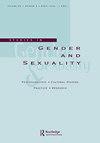《男孩不哭》中再现的擦除
Q3 Social Sciences
引用次数: 0
摘要
摘要:这篇个人叙事文章探讨了1999年电影《男孩不哭》中擦除和再现的方式。作者回顾了他作为一个年轻的变性人观看这部电影刚上映时的经历。他描述了多种形式的抹杀:他自己的抹杀,菲利普·德文被排除在电影叙事之外,甚至布兰登·蒂娜的跨性别男子气概。作者考虑了这部电影对他自己生活的影响,以及电影中的擦除与美国当代政治气候的关系。本文章由计算机程序翻译,如有差异,请以英文原文为准。
Erasure Through Representation in Boys Don’t Cry
ABSTRACT This personal narrative essay examines the way erasure occurs alongside representation in the 1999 film Boys Don’t Cry. The author reflects on his experience seeing the film when it was first released, as a young transmasculine person. He describes multiple forms of erasure: his own, the exclusion of Philip DeVine from the film’s narrative, and even of Brandon Teena’s trans masculinity. The author considers the impact of the film on his own life and the way erasure in the film relates to the contemporary political climate in the United States.
求助全文
通过发布文献求助,成功后即可免费获取论文全文。
去求助
来源期刊

Studies in Gender and Sexuality
Social Sciences-Gender Studies
CiteScore
0.80
自引率
0.00%
发文量
15
期刊介绍:
Beginning in the final two decades of the 20th century, the study of gender and sexuality has been revived from a variety of directions: the traditions of feminist scholarship, postclassical and postmodern psychoanalytic theory, developmental research, and cultural studies have all contributed to renewed fascination with those powerfully formative aspects of subjectivity that fall within the rubric of "gender" and "sexuality." Clinicians, for their part, have returned to gender and sexuality with heightened sensitivity to the role of these constructs in the treatment situation, including the richly variegated ways in which assumptions about gender and sexuality enter into our understandings of "normality" and "pathology."
 求助内容:
求助内容: 应助结果提醒方式:
应助结果提醒方式:


